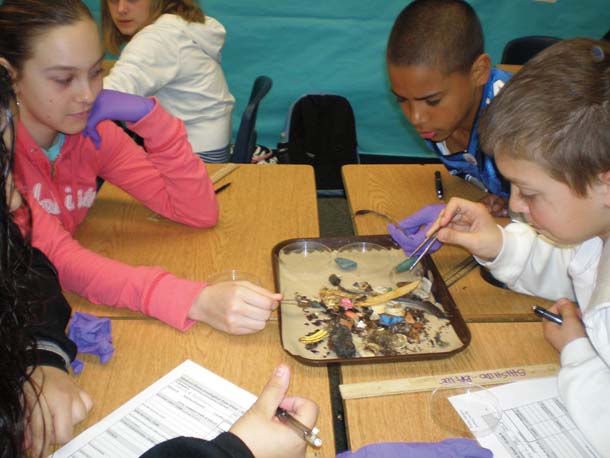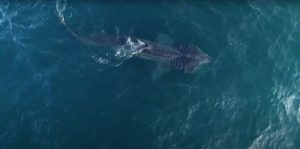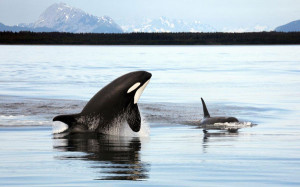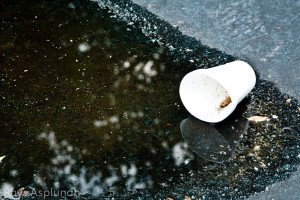As any sixth grader in Benicia knows, a bottle cap dropped on the sidewalk in your neighborhood may end up in the stomach of an albatross chick on Kure Atoll 3,000 miles west of San Francisco. After that cap flows down a storm drain into the Bay and out the Golden Gate, likely as not it will end up in the North Pacific Subtropical Gyre, a vortex of rotating currents between California and Japan. There it will enter the Eastern Garbage Patch, a diffuse soup of perhaps 3.5 million tons of floating plastic trash, where an albatross may mistake it for food, swallow it, and later feed it to its chick waiting back on Kure Atoll.
To marine scientist Carol Keiper, cofounder of the nonprofit research organization Oikonos Ecosystem Knowledge, these albatrosses are “winged ambassadors for a clean ocean,” charismatic messengers at the heart of a program she developed to teach students about plastic pollution. Each year, sixth graders at Benicia Middle School learn the natural history of albatrosses and how their survival is threatened by our culture’s addiction to plastic. With gloved hands and tweezers, students dissect cigar-shaped boluses of indigestible material regurgitated by albatross chicks on faraway Pacific atolls. Aside from a few noses wrinkled at the odor, the students are engrossed in their task.
- Benicia Middle School students sort and identify sources of plastic debris found in an albatross bolus. Photo by Carol Keiper.
“They get really excited; they hold things up and talk about the unusual items,” says Keiper. One sample includes a cigarette lighter, bottle caps, and small plastic bits that combined make up about half the bolus. In an unpolluted ocean, that bolus would contain only organic matter like squid beaks.
In multiyear studies on several breeding islands, every single albatross chick was fed plastic trash by its parents. And it’s not just albatrosses that suffer. From tiny zooplankton to the largest mammals, 267 species of marine creatures worldwide are known to be harmed by plastic pollution.
“Only we humans make waste that nature can’t digest,” says Captain Charles Moore, founder of Long Beach-based Algalita Marine Research Foundation. He has been studying marine plastic debris since 1997, when he discovered the Eastern Garbage Patch while sailing from Hawaii. Preliminary results from Algalita’s most recent voyage show that the surface density of floating plastic has doubled in just 10 years. This summer, Algalita will analyze fish tissue samples for pollutants associated with plastic particles. These chemicals concentrate up the food chain, so they may already be in our seafood.
Back in Benicia, the sixth graders study the movements of albatrosses under the tutelage of Water Education Specialist Susan Alfeld. The students first plot the Eastern Garbage Patch on a map and then, using transmitter data from albatrosses tagged at Cordell Bank, chart the birds’ travel, discovering that they spend about half their time in the Eastern Garbage Patch.
Once the students understand the scope of the problem, they start working on solutions. They pick up trash, stencil warnings on storm drains, and educate their friends and families. Sixth grader Halie Stockett gets the message. “Now when I see trash lying around, I think I should go pick it up.” That’s gratifying for Keiper, who started beach cleanups when she moved to Benicia 25 years ago. “I love the ocean so much I can’t stand seeing it screwed up.”
Oikonos makes its “winged ambassadors” program available to teachers around the country. So far, schools from San Francisco to Nashville have requested materials. In all, more than a dozen schools and 2,000 students have participated.
Ocean plastic pollution is getting more attention around the Bay Area. Local governments are enacting plastic bag bans and other restrictions. Pending state legislation will regulate bottles and takeout food containers and hold producers responsible for their packaging.
Local governments, citizens, and nonprofits are redoubling their efforts in waterway cleanups. In 2008, 73,000 people picked up more than a million plastic bottle caps on Coastal Cleanup Day, scheduled for September 19 this year.
But the solution truly begins at home with everyday choices and actions. As Carol Keiper advises, “We just need to change the way we think about plastic.”
Follow these links to learn more about Oikonos’ education program as well as ocean conservation in general and specific ways you can reduce your use of disposable plastic.

.jpg)




